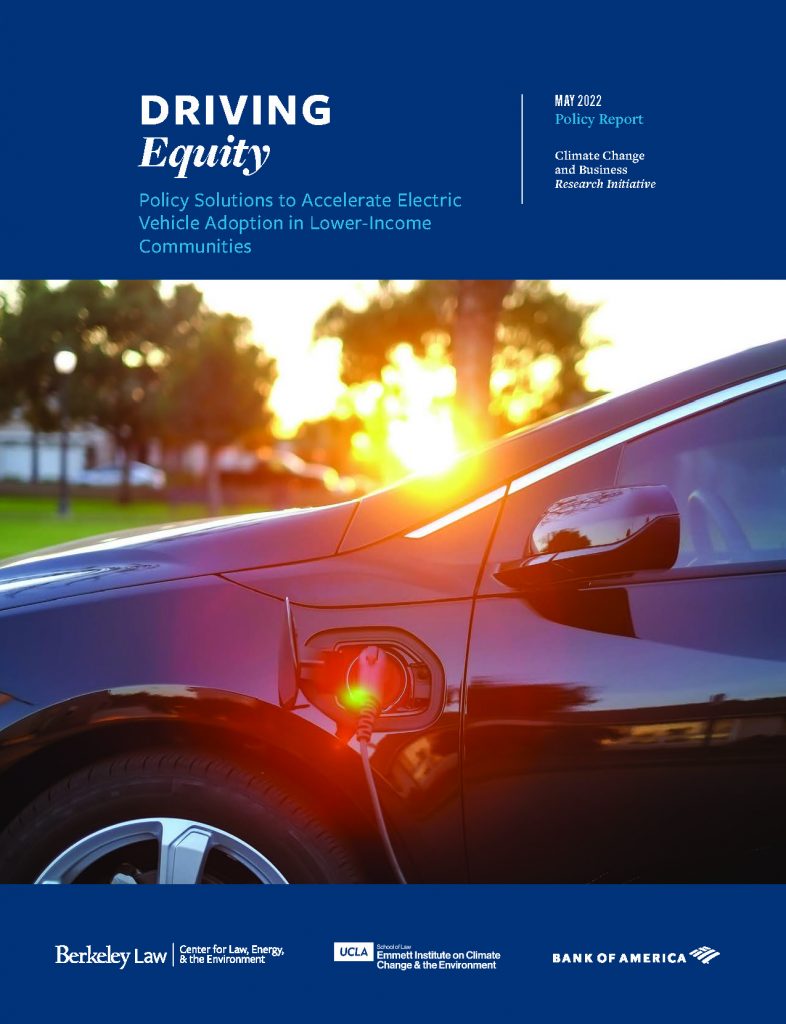Berkeley Law’s Center for Law, Energy and the Environment (CLEE) and UCLA Law’s Emmett Institute on Climate Change & the Environment released a new policy report today, Driving Equity: Policy Solutions to Accelerate Electric Vehicle Adoption in Lower-Income Communities. The report highlights key policy solutions to ensure that California’s electric vehicle (EV) transition is equitable and inclusive. Top-priority strategies include increased rebates and incentives for lower-income vehicle purchasers; financial and infrastructure support for charging networks; and funding for greater outreach by community-based organizations.
To achieve ambitious state greenhouse gas emission reduction and carbon neutrality goals, California must significantly reduce emissions from transportation, which is the single greatest source of statewide and national emissions. California has made significant progress to date through its ambitious incentive and regulatory programs, recently surpassing 1 million cumulative EV sales and representing nearly 40 percent of all EV sales nationwide.
But any California resident will know that today most EVs are higher-cost models, with base prices over $40,000 or $50,000 for newly released vehicles, federal tax credits unavailable for legacy manufacturers, and base-price models hard to locate. Most are driven by residents of higher-income areas and single-family homes with private or workplace charging access.
California will not effectively and equitably phase out fossil fuel vehicle sales in the next 13 years (as required by executive order) unless all Californians have access to affordable EVs and robust charging infrastructure that meet their transportation and community needs.
To address this challenge, CLEE and the Emmett Institute convened state, local, industry, and environmental leaders to develop priority solutions to increase EV adoption in California’s lower-income communities. Participants laid out a vision for an equitable EV transition that would place community stakeholders at the forefront of investment decision-making; embrace public transit and active transportation priorities while ensuring connectivity through affordable private and shared vehicles; include abundant public charging and support associated grid infrastructure; and ensure availability of durable EVs, including pickups, to meet a range of driver needs.
The group identified key barriers to this transition including limited financial capacity to acquire new higher-cost vehicles; limited access to convenient and affordable charging; and limited public awareness and relevant outreach. Policy solutions to overcome those barriers include:
- Increasing existing vehicle rebates to lower upfront purchase prices. The Clean Vehicle Rebate Project and Clean Cars 4 All programs, as well as utility rebates, offer generous incentives for EV buyers. However, even with vehicle and battery prices broadly declining, purchase prices are still higher than many lower-income residents can afford. No manufacturer has yet released a full-range economy model, and used EVs are hard to locate. Increased purchase incentives for lower-income buyers could help bridge the gap until more models and used vehicles are available (the CVRP and CC4A programs already include income caps).
- Creating a subsidized charging payment system. While EV charging costs are generally lower per mile than gasoline refueling, ultimately generating cost savings compared to gasoline vehicles, these savings can take many years to accrue. The legislature could create a subsidized card for use at public chargers to incentivize the switch, ensure that lower-income Californians have the financial ability to charge when needed, and promote installation of chargers in a range of communities.
- Funding community-based organizations. Programs like the San Joaquin Clean Vehicle Empowerment Collective have demonstrated the potential of CBOs to provide information, technical assistance, and outreach optimally targeted to the EV interests and needs of under-resourced communities. The legislature could provide direct funding for similar organizations throughout the state to ensure that all Californians are aware of and can access the incentives and benefits available to them.
You can download the report here. Please also join us on May 24 at 1pm PT for a webinar to discuss the report and transportation decarbonization equity with:
- Commissioner Patty Monahan, California Energy Commission
- Jessie Denver, East Bay Community Energy
- Paul Francis, KIGT
This post co-authored by Ted Lamm.



